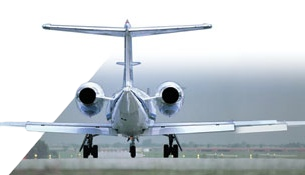
DynEd's Aviation English program is now being used by thousands of active pilots, controllers, and flight students. Clients include Air China, Emirates, Vietnam Airlines, Air Astana, BeiHang Flight College, TransPac Aviation Academy, China Airbus, TunisAir, and the Colombian Air Force. DynEd is also advising CAAC on the development of their testing program.
Recent News!
DynEd's Aviation English solutions have been adopted by Jeppesen, a Boeing Company, as their preferred Aviation English Vendor. Jeppesen, a Boeing Company, will market and sell DynEd's programs as part of the quality training solutions offered to their wide range of customers including those from commercial aviation, general aviation, business aviation, universities, and flight training organizations. Further announcements pending.
DynEd's Aviation English solutions develop a level of oral English proficiency that can be relied on in times of stress and unpredictability so that concerns for accurate communication and communication strategies do not interfere with or delay both piloting and controller tasks. In addition to specific Aviation English, general English language proficiency is a requirement to optimize safety concerns, and that realization is reflected in the ICAO specifications and goals. DynEd's suite of products meets these needs. A major benefit for airlines is the elimination of costly pilot down-time, since pilots and controllers may use the system anytime, anywhere with only periodic teacher/class support in a blended configuration.
| Level |
|
|---|---|
| Features |
|
Aviation English Course Focus
Oral English skills
for air safety
A fluency-based, multimodal system that accelerates the development of English language proficiency, particularly the oral skills and pronunciation demanded by ICAO Level 4.
Aviation English for Pilots and Aviation English for Controllers focus on key language concepts, vocabulary, and phraseology necessary to improve airline safety, both on the ground and in the air. As the demand for international air travel grows, there is also a growing shortage of qualified commercial pilots and controllers with the requisite English language skills necessary to communicate effectively. This has become such a concern that the International Civil Aviation Organization (ICAO) has mandated that all commercial pilots flying international routes must meet stringent new standards for English language proficiency.
DynEd's Aviation English courses significantly accelerate English proficiency gains in an aviation context, with the primary goal of improving airline safety. The courses were developed by DynEd and a team of pilots and experts from Edgewater College in Ireland, AES and FRA in the US.
Aviation English for Pilots and Aviation English for Controllers are supplementary courses designed to:
- prepare pilots and controllers to reach and surpass ICAO Level 4 "Operational" English proficiency;
- be used in parallel with DynEd's core language courses, with regular on-line study over a period of 4-6 months, depending on entry level, study frequency and study time per week;
- be used in a cost-effective blend with periodic classroom or tutor support that focuses and extends the language into aviation contexts and provides expert feedback;
- be delivered and supported by a DynEd-licensed professional training organization with specific aviation-related experience;
- be used and supported by DynEd's award-winning Records Manager and Intelligent Tutor systems to provide real-time monitoring and control of study activities to ensure efficient study and progress from start to finish.
Course Content
Aviation English for Pilots and Aviation English for Controllers have 6 units, built around a core language syllabus designed to develop listening and speaking fluency. The aviation focus is on communication examples from pilot to controller and from pilot to pilot. Dialogs and examples include exchanges provided by NASA, industry associations, public transcripts, and original materials written to specification by experts to illustrate key points.
Each unit presents language examples of normal and non-normal situations, spoken with a variety of voices and background noise. In addition to dialogs and comprehension questions, each unit has exercises that develop pronunciation, oral fluency, vocabulary and syntax - in coordination with DynEd's award-winning core courses.
| Unit One | Unit Two | Unit Three | |||
|---|---|---|---|---|---|
| Pre-flight | Weather, clearance delivery, walk-around inspection, push-back, taxi instructions, CRM, delays, on-ground emergencies, getting to the runway, and more; | Departure & Take-Off | Ground navigation, takeoff procedures, emergencies, aborts, fire, traffic issues, wind shear, wake turbulence, bird strikes, weather issues, speed & heading, "without delay", and more; | Climb/Cruise & Descent | Traffic, TCAS, requesting route changes, turbulence, medical emergencies, fire, pressurization, conditional clearances, "until further notice," and more; |
| Unit Four | Unit Five | Unit Six | |||
| Approach & Landing | Traffic, flow control, weather, mechanical problems, "at your discretion", vectoring and ILS issues, missed approach, and more; | Taxi, Shutdown & Post-flight | Taxiway, CRM, medical equipment, navigating unfamiliar airport, gate delays, post-flight checklists, and more; | Case Studies & Accident References | Historical accounts of accidents, prevention measures, and related vocabulary. |
Lesson Types
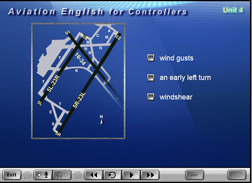 Presentation Lessons introduce language models in the context of normal, non-normal, and emergency situations. Students develop comprehension, structure, pronunciation, integration, and oral fluency skills as they practice the language over a number of study sessions. Extension Activities are available to qualified instructors to help guide students in tutorials or classroom sessions. The focus is always on safety and ensuring situation awareness.
Presentation Lessons introduce language models in the context of normal, non-normal, and emergency situations. Students develop comprehension, structure, pronunciation, integration, and oral fluency skills as they practice the language over a number of study sessions. Extension Activities are available to qualified instructors to help guide students in tutorials or classroom sessions. The focus is always on safety and ensuring situation awareness.
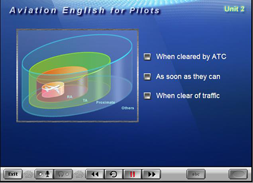
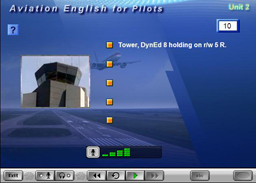 Key Phrases: These effective and motivating exercises develop pronunciation and oral fluency. They use advanced speech recognition technology that evaluates and gives feedback as the student repeats back instructions. A large number of exchanges are included, and should be practiced as often as possible.
Key Phrases: These effective and motivating exercises develop pronunciation and oral fluency. They use advanced speech recognition technology that evaluates and gives feedback as the student repeats back instructions. A large number of exchanges are included, and should be practiced as often as possible.
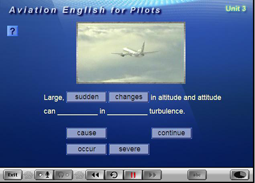 Focus Exercises: These exercises focus on key language appropriate for ICAO 4 comprehension and structure targets.
Focus Exercises: These exercises focus on key language appropriate for ICAO 4 comprehension and structure targets.
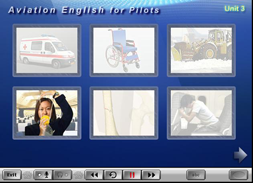 Vocabulary: Important vocabulary is recycled throughout the course.
Vocabulary: Important vocabulary is recycled throughout the course.
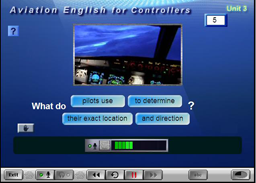 Commands and Questions: Advanced speech recognition technology is used to improve fluency, pronunciation, structure, and integration. This kind of exercise should be used frequently.
Commands and Questions: Advanced speech recognition technology is used to improve fluency, pronunciation, structure, and integration. This kind of exercise should be used frequently.
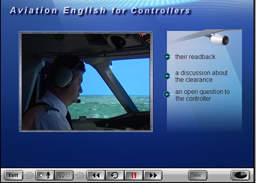 Video: Aviation videos are used for comprehension and vocabulary work. They are also used to stimulate class discussion and analysis. The focus is always on safety.
Video: Aviation videos are used for comprehension and vocabulary work. They are also used to stimulate class discussion and analysis. The focus is always on safety.

